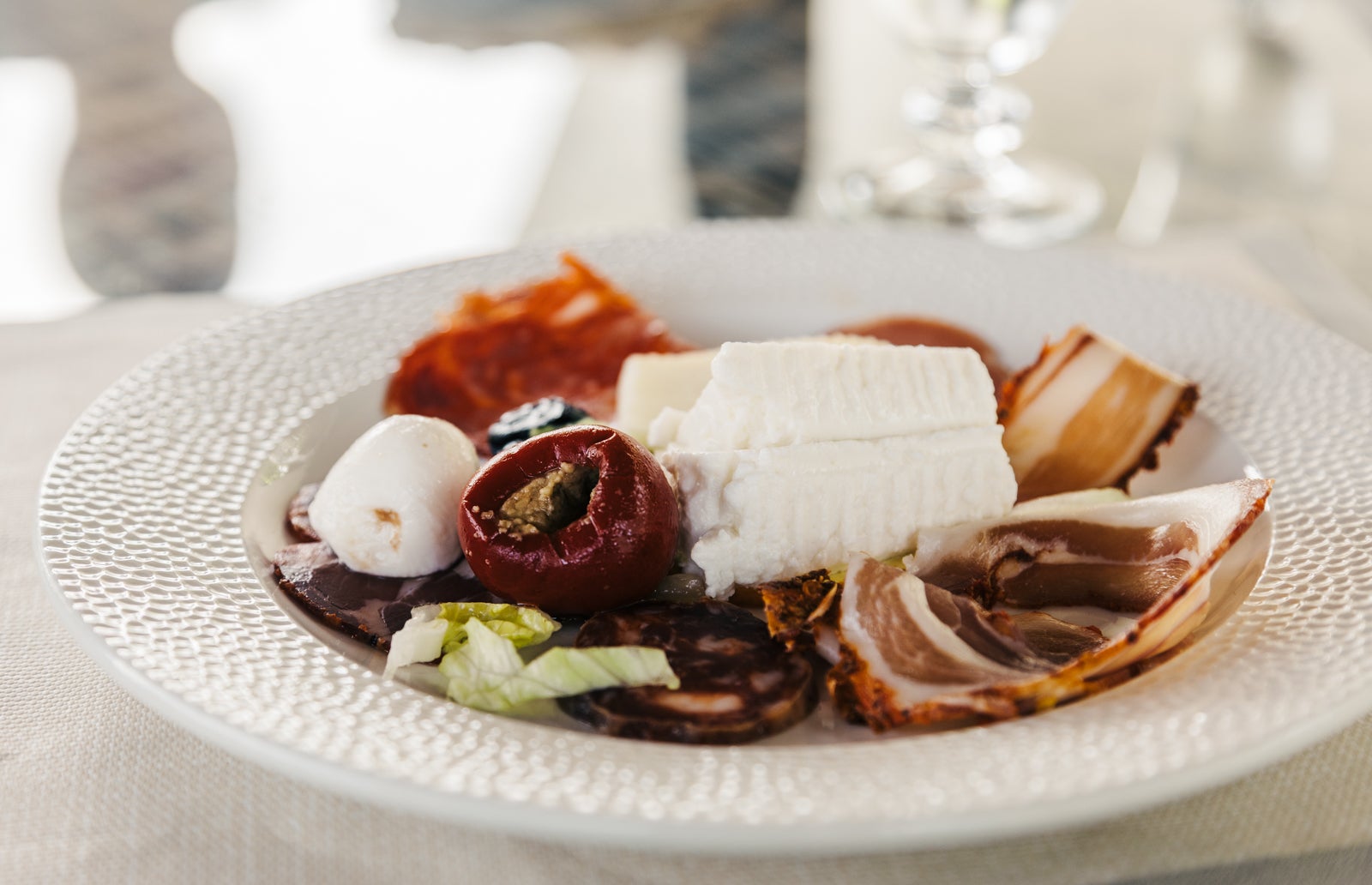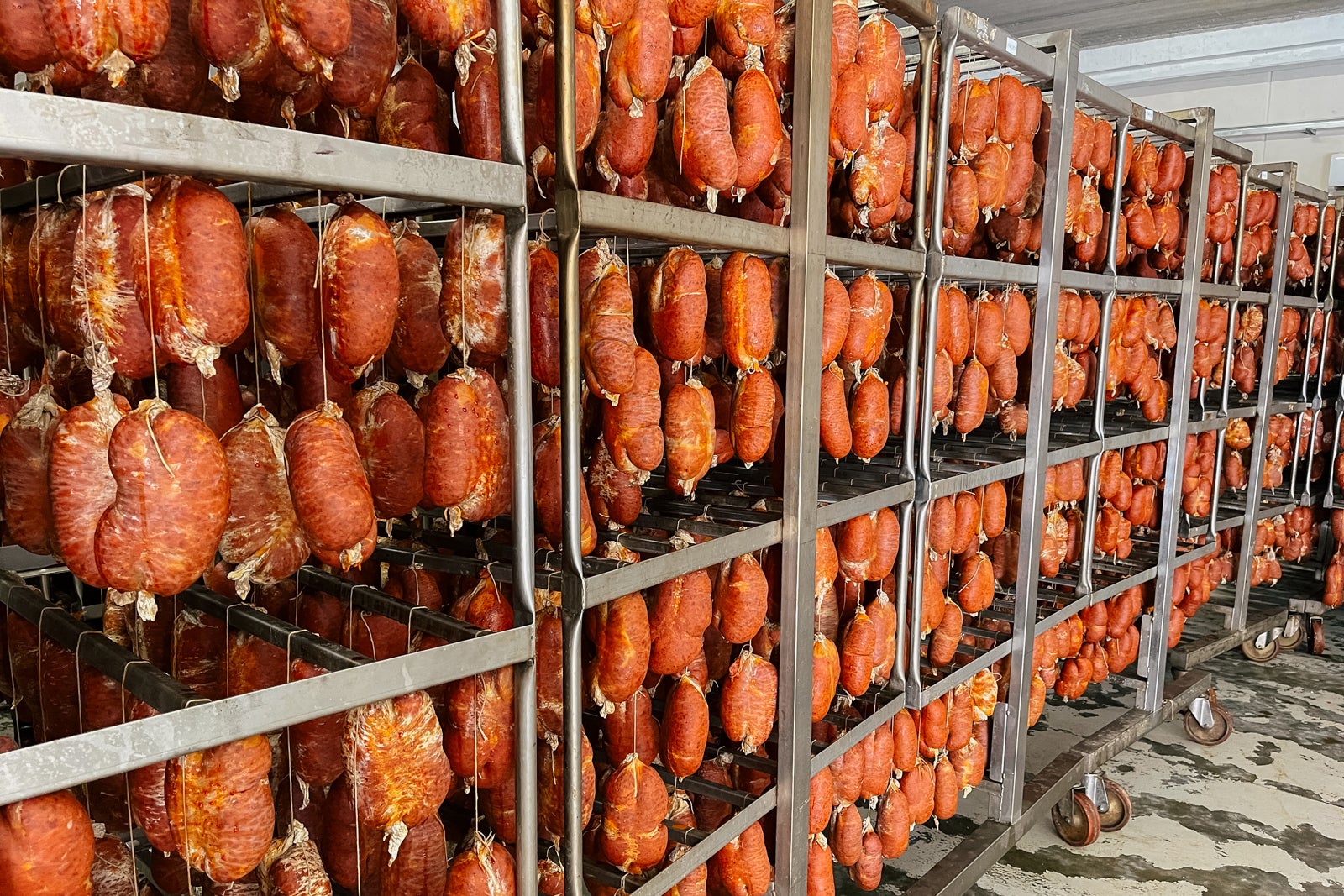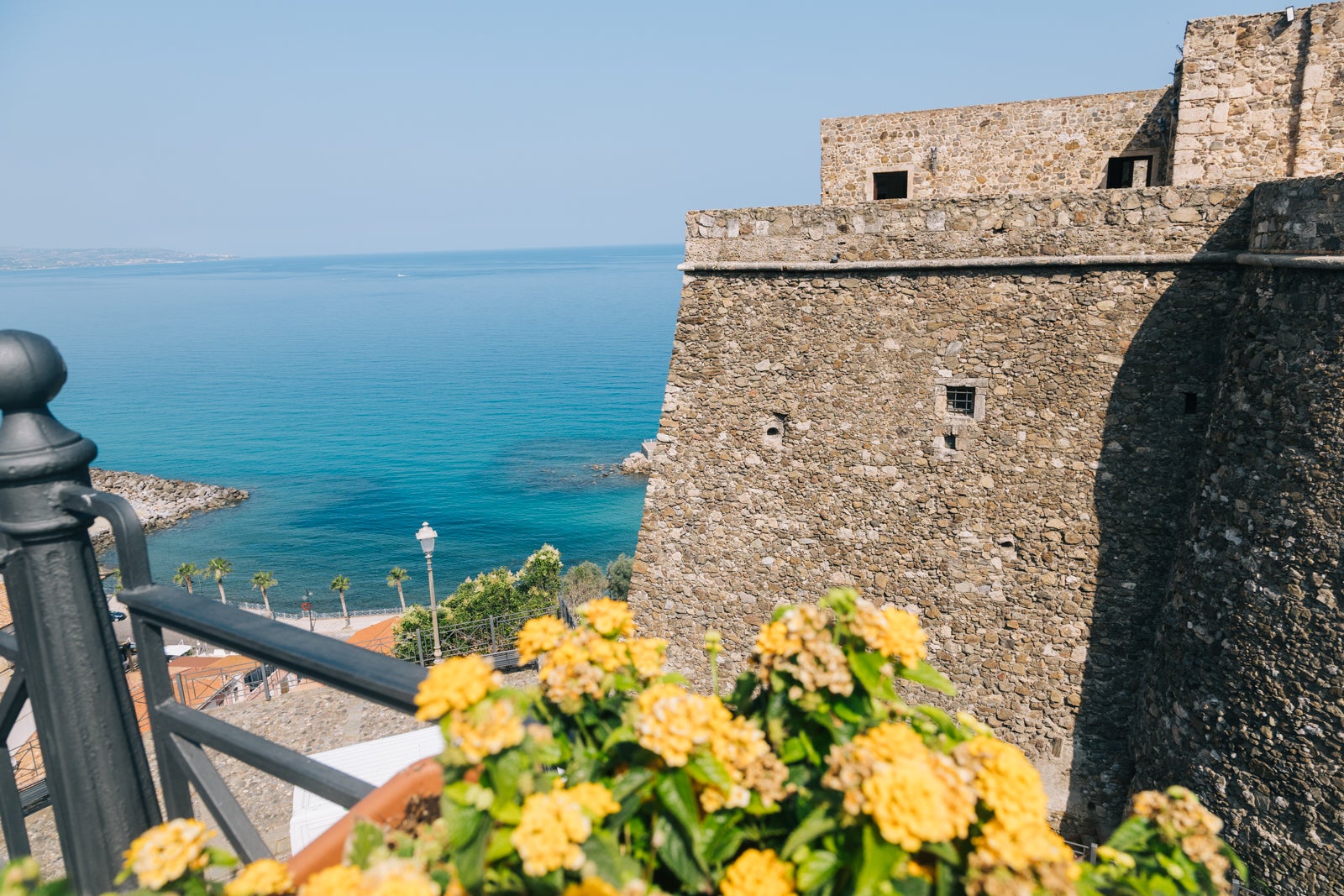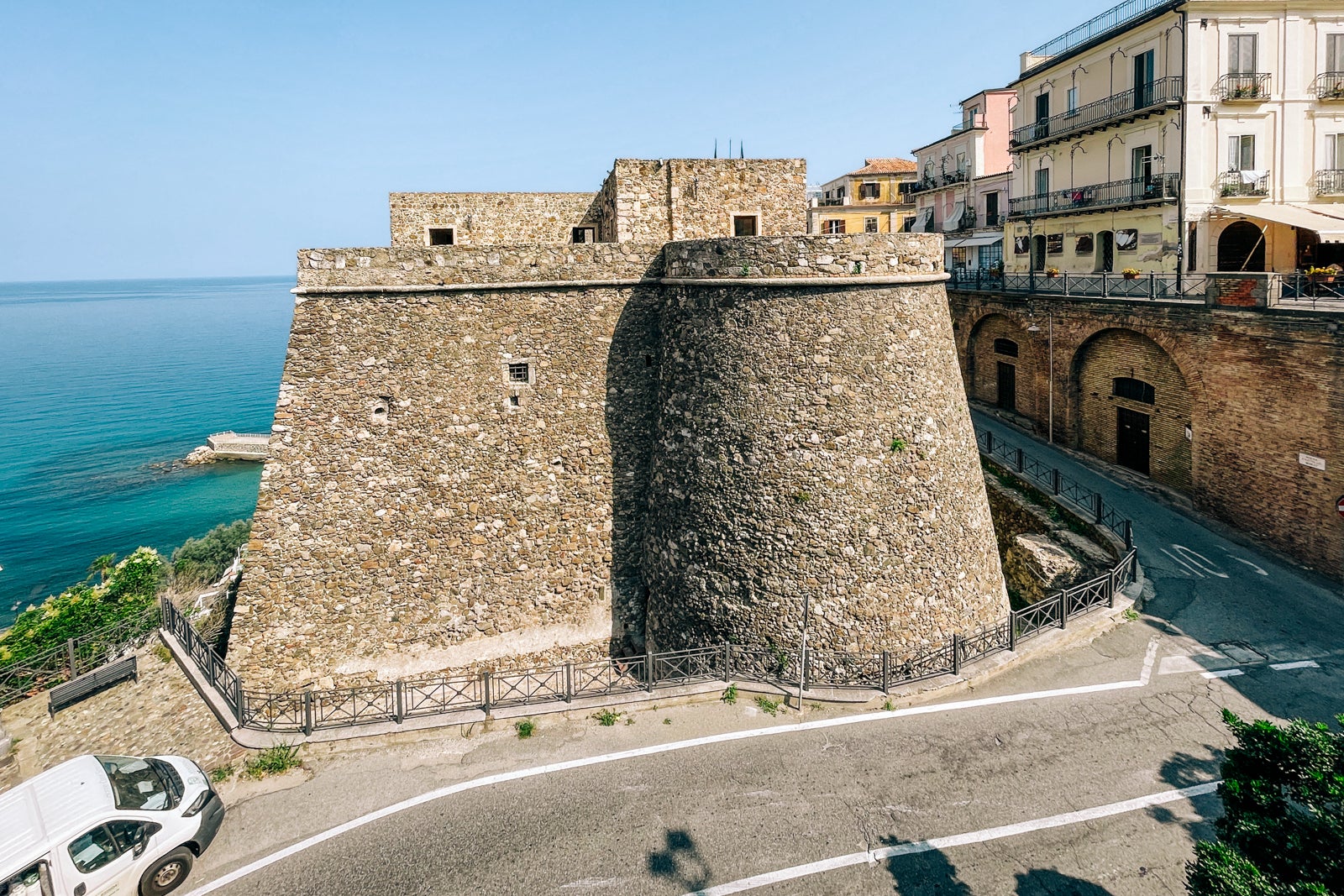Does your day start like this? You mobile-order an iced caramel macchiato, scroll your social feeds and maybe type an AI prompt to help you research a project for work.
Italians living on the Calabria peninsula, the “toe” of the country’s “boot,” greet the day a bit differently. They tend a flock of sheep, make cheese, inspect the olive and bergamot citrus groves or fish for swordfish, bluefin tuna and sardines.
This region of Italy, still mostly undiscovered by Americans, is gifted with more than 500 miles of prime coastline — the Tyrrhenian Sea to the north, the Ionian Sea to the south and Sicily just a quick ferry ride to the west.
1 of 3
Soverato beach. ANDREA ROTONDO/THE POINTS GUY
And the history! People have lived here since the Stone Age.
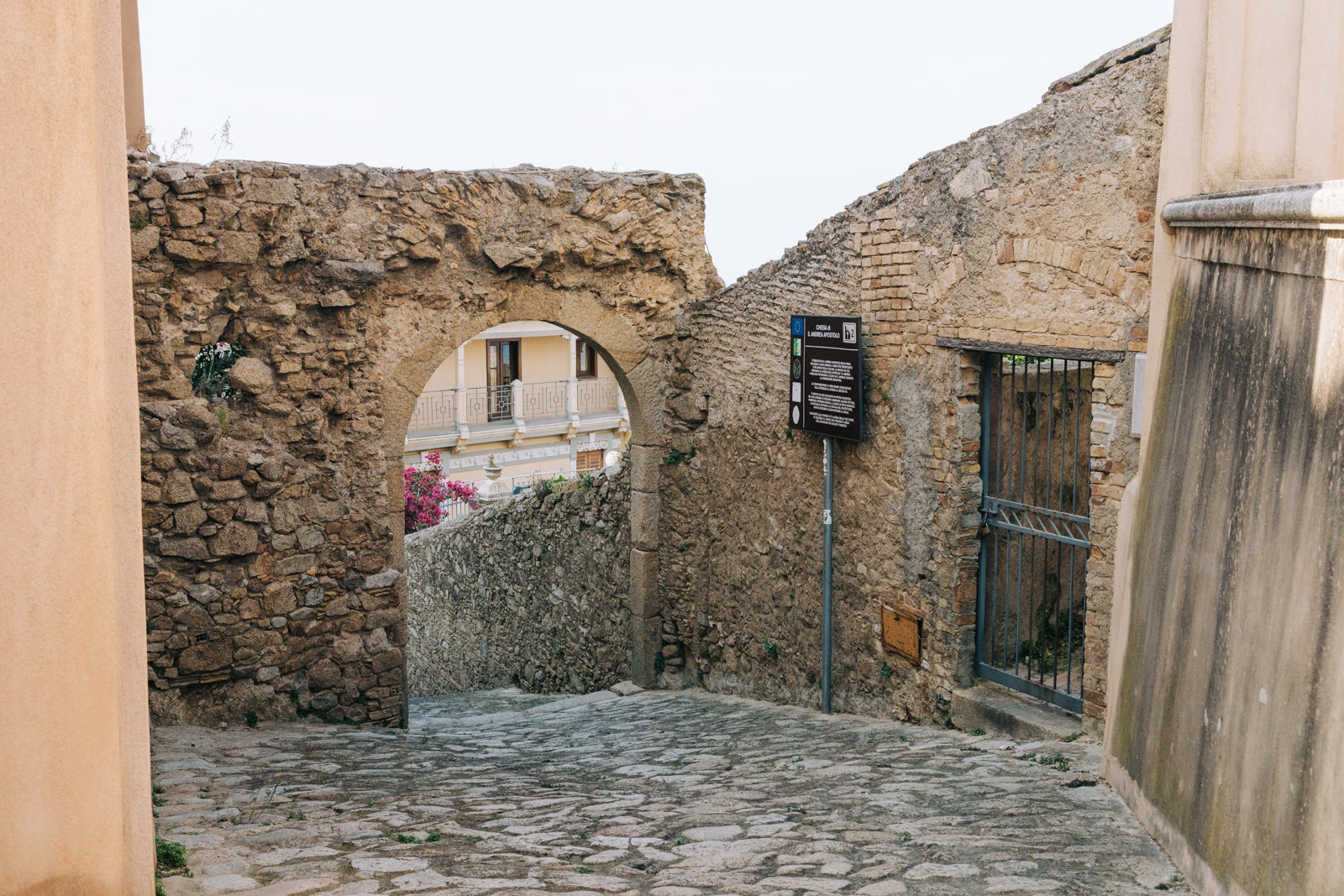
The Ancient Greeks conquered the region as part of Magna Graecia (Great Greece). The Romans came next, followed by the Byzantines, Normans, Sicilians, Aragonese, Spanish, French and others before the unification of Italy in 1861.
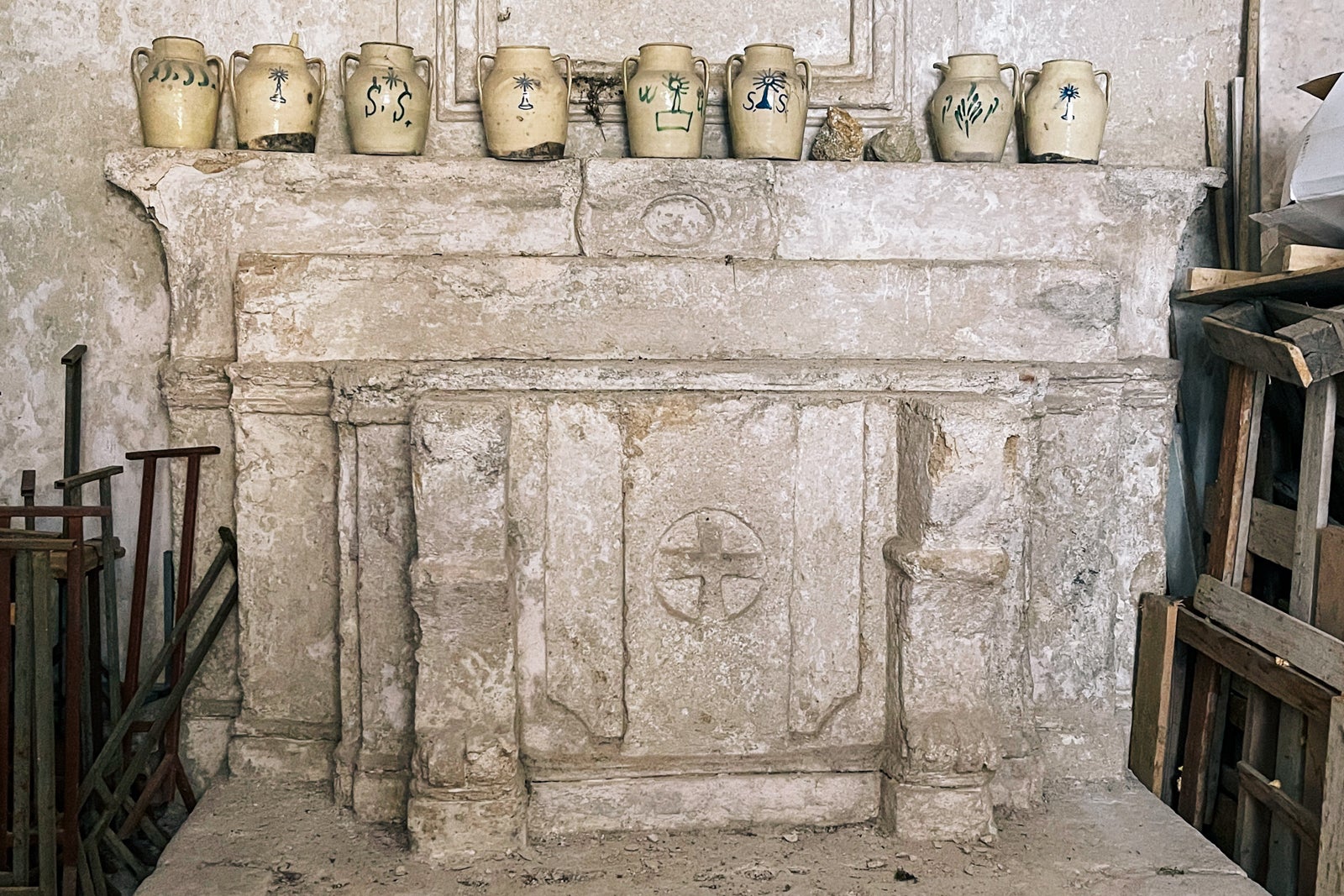
Despite a series of devastating earthquakes — including five in 1783, one in 1905 and another in 1908 — there are still hilltop villages with intact centuries-old buildings and sites, such as the 10th-century Norman castle of Rocca Imperiale and the former Greco-Roman city of Skylletion-Scolacium, now an archaeological park along the Gulf of Squillace.
Several national parks and plenty of outdoor adventures await, too. If you love hiking, climbing, biking or boating, you’ll find it here.
But I’ve saved the best part for last: the people. I may be biased — because, after all, I am a granddaughter of Calabria — but the people you’ll meet in this region are some of the sweetest, most helpful yet tough individuals you’ll find on the planet. Southern Italy has always been hard-scrabble, and Calabrians have made the most of their resources with ingenuity, common sense and a strong reliance on community.
Though off Italy’s more-trodden paths, I guarantee Calabria will bewitch you. That’s why it’s on TPG’s list of where to go in 2025. As the Catholic Church continues to celebrate its 2025 Jubilee with record crowds heading to Rome — and also swelling the country’s other “greatest hits” cities of Florence, Venice and Milan — instead consider a visit to this place that may change the metrics by which you’ll judge all your future Italian getaways.

Reward your inbox with the TPG Daily newsletter
Join over 700,000 readers for breaking news, in-depth guides and exclusive deals from TPG’s experts
Related: Rome Jubilee 2025: How to avoid the crowds
I just returned from Calabria to see the villages where my grandfather grew up. Here’s my advice for planning your own visit to the region.
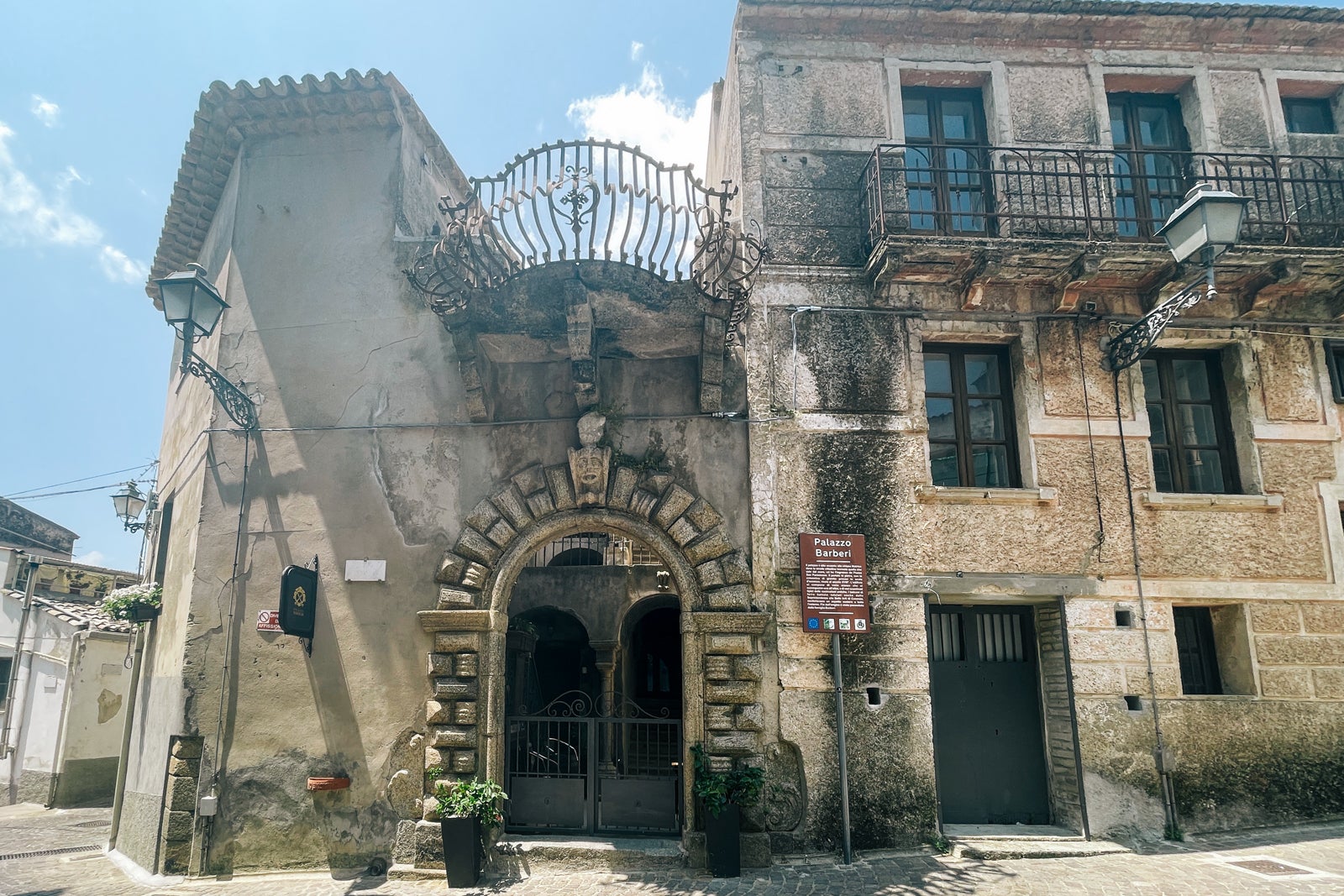
When to go
Shoulder seasons — April to May and September to October — are ideal for exploring. The weather is mild, and there are usually fewer crowds. July and August can be quite hot, and the major tourist areas, such as Tropea, can be very busy. Calabria is a popular summer vacation spot among Italians, so you’ll be in good company.
Related: Shoulder season goes mainstream
How to get to Calabria
There are three airports in Calabria: Lamezia Terme International Airport (SUF), Reggio Calabria Airport (REG) and Crotone-Sant’Anna Airport (CRV). There are no nonstop flights from the United States; however, you can connect to these airports through other European cities like Rome, Milan, Venice, London, Zurich, Vienna, Madrid and Frankfurt. Check FlightConnections.com to find all the options.
If your vacation starts in Sicily, you can also embark on a ferry from Messina to Villa San Giovanni in Calabria. The trip only takes 20 minutes.
Related: The best ways to travel to Italy with points and miles
How to get around
The lesser-known nature of Calabria is both a pro and a con. It can be tougher to get around than in a city like Rome. Major tourist areas, such as Tropea, have Uber and other ride-hailing platforms available, but for more rural villages and destinations, you’ll either need to rent a car or hire a private driver (of which there are many). If you don’t want to rent a car, there is train service between some popular tourist destinations.
If you’re used to driving curvy switch-back roads and can maneuver in towns with incredibly narrow passageways, driving likely won’t be an issue.
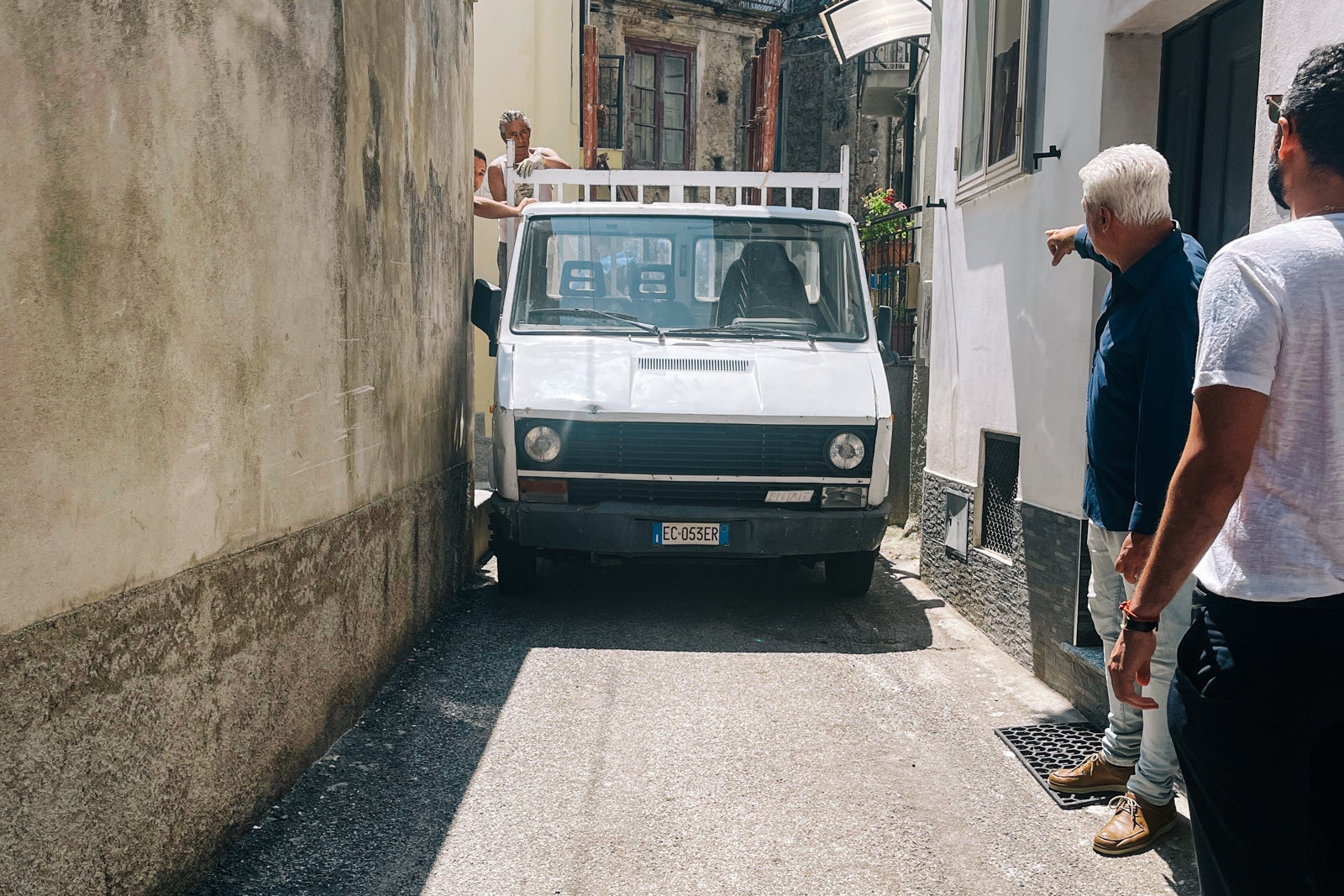
I always hire a driver or a driver-guide who can also pass along context I wouldn’t otherwise uncover. I also like getting insider recommendations for markets, restaurants and things to do.
Danilo Verta, owner of Vita Calabra Tours, is my go-to bilingual guide. He offers private and small group tours across Calabria. He recently accompanied my husband and me on a customized tour of Montauro, Sant’Andrea Apostolo dello Ionio, Gasperina and Soverato. He arranged for a university history professor, who grew up in Montauro, to join us. We learned so much from him about the place where my ancestors lived. It was a remarkable experience, and we plan to return with more of the family.
Vita Calabra Tours offers personalized ancestral tours, introductory itineraries to Calabria and more adventurous expeditions that include cycling and/or white-water rafting. He also has a gift for pairing his guests with the right lodgings, activities and dining experiences. Add him to your contacts database; he’s a keeper.
Where to stay
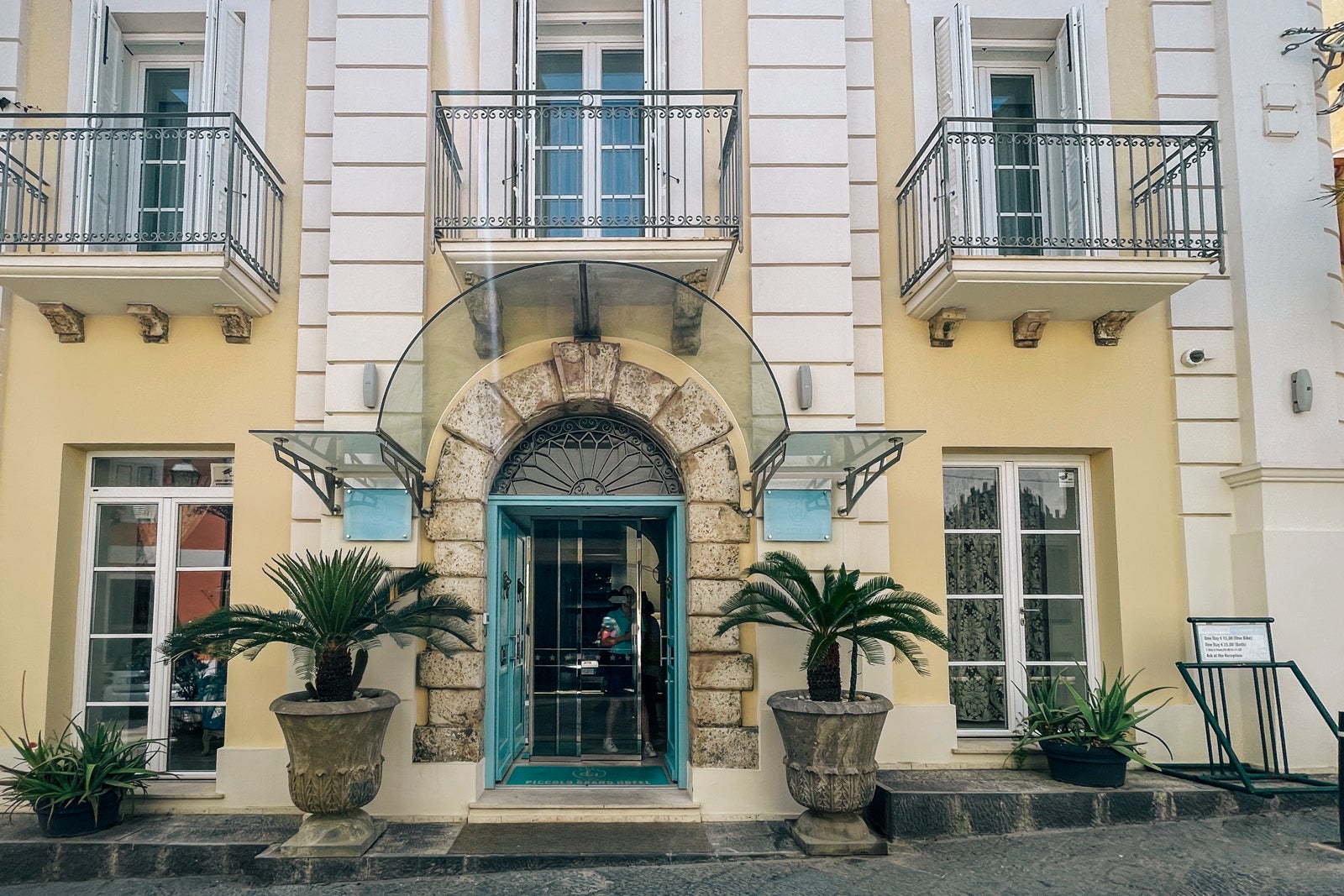
There are very few traditional points hotels in Calabria that are part of brands like Marriott, Hyatt or IHG. One luxury option is Praia Art Resort in Praialonga near Isola di Capo Rizzuto. It’s part of Small Luxury Hotels of the World, so you can use your Hilton Honors points there (usually around 95,000 points per night). Or, there are three Best Westerns: Villa Fabiano Palace Hotel in Rende, Hotel Perla del Porto in Cantanzaro on the beach overlooking the Gulf of Squillace and Hotel Class near the airport in Lamezia Terme. The points cost per night ranges from 20,000 to 24,000 Best Western points, but check the cash rates since the nightly rates can be under 90 euros per night.
But don’t despair. If you have Chase Ultimate Rewards points, plenty of hotels, inns and B&Bs are bookable via cash or points through the Chase Travel portal. Some accommodations are even a fantastic deal using Chase’s new Points Boost option.
Related: Why Chase’s Points Boost is an outstanding new way to book hotels on points
Calabria itineraries for first-timers
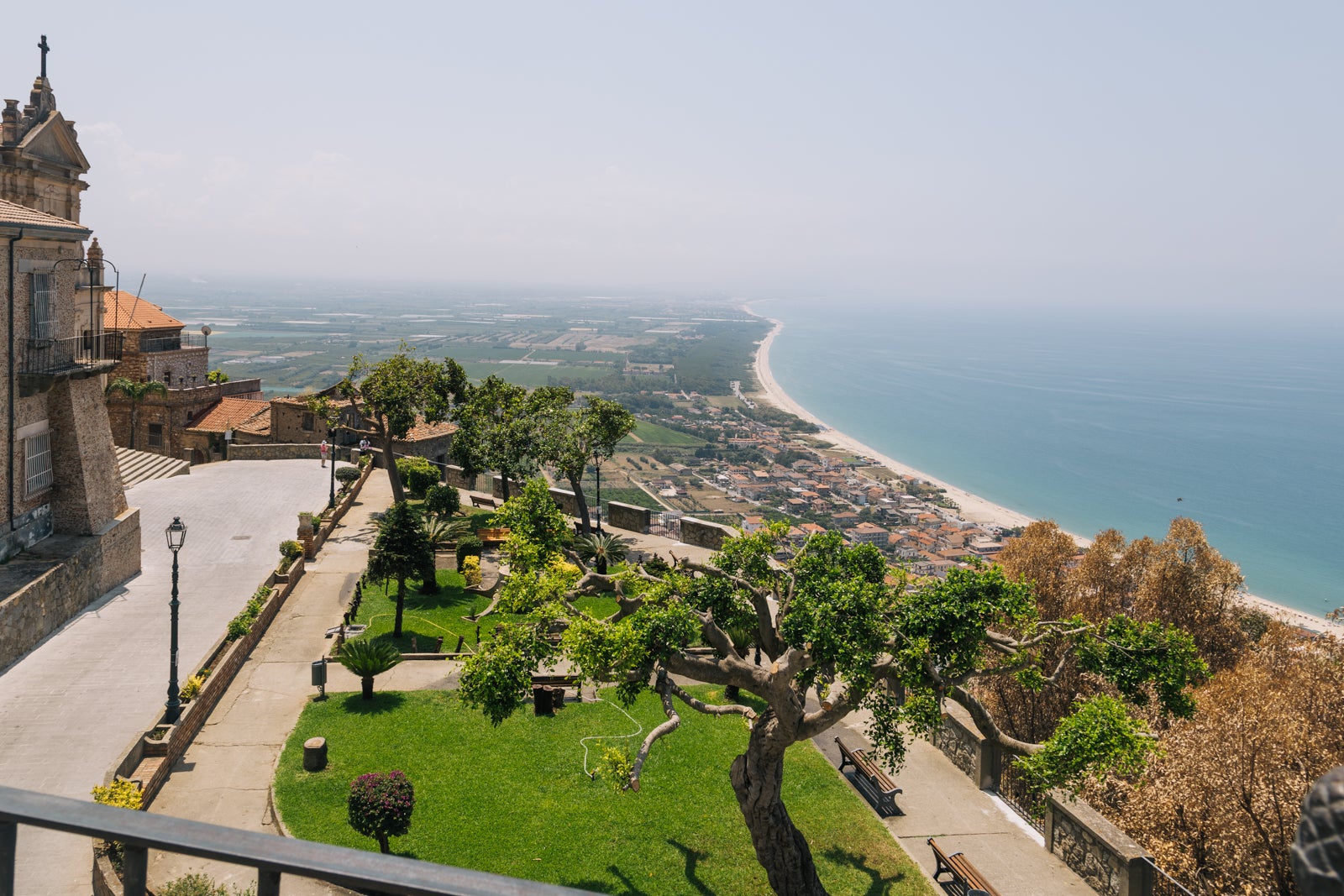
If you know nothing about Calabria, here are two itineraries ideal for first-time visitors. I’ll also name three of my favorite places to visit and explain them in more detail after these itineraries.
Visit Calabria’s 3 national parks
This path takes you to three of the region’s most spectacular national parks and allows time to visit special villages, such as Scalea, Diamante, Santa Severina and the city of Reggio Calabria.
Days 1–3
- Fly into SUF.
- Drive north to Scalea (great beaches) or Diamante (known for the more than 100 murals painted around town) to set up a home base.
- Visit Pollino National Park, a UNESCO Global Geopark in the southern Apennine Mountains. It’s one of Italy’s largest national parks and has a variety of hiking trails.
Days 4–6
- Head south to Cosenza for its cathedral, open-air museum and the Castello Normanno-Svevo.
- Then take day trips to Sila National Park for hiking, biking or boating on its lakes.
- Continue to Santa Severina, one of Italy’s most beautiful medieval hilltop villages.
- Next, visit Isola di Capo Rizzuto (check out its Marine Reserve) or Crotone for the Castello Aragonese. Stay in that area for a few days or head south toward Soverato.
Days 7–8
- Enjoy the Gulf of Squillace and the Ionian Sea and visit the medieval town of Badolato and its marina below.
- Spend time at Aspromonte National Park. Take a Jeep safari, hike, rent mountain bikes or go horseback riding.
Days 9–10
- Finish with a few days in the city of Reggio Calabria. (See below for more information about this city.)
Day 11
A taste of small-town Calabria
Days 1–2
Days 3–4
- Travel north along the coast to Scilla and the fishing village of Chianalea along the Costa Viola.
Days 5–7
- Thread your way upward along the coast, stopping at the overlook for Capo Vaticano beach (better accessed by a boat ride later in the trip) before arriving in Tropea (see below for more details about this town) and checking into your hotel.
- Explore Tropea’s narrow streets and see the sanctuary of Santa Maria in the late afternoon.
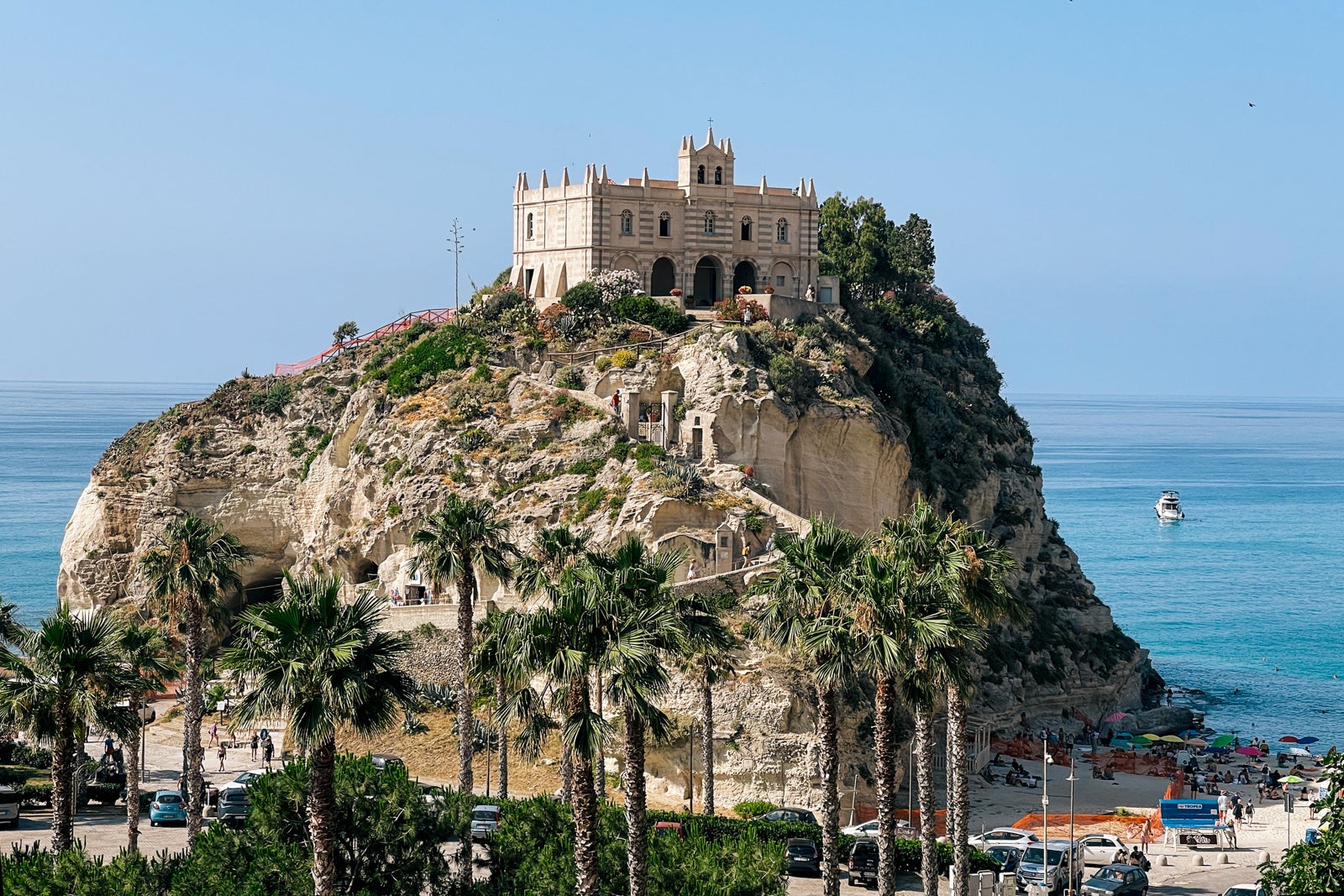
- Devote a day to fun and sun. Take a boat excursion to Capo Vaticano beach or just sunbathe at one of the many beaches in and around Tropea.
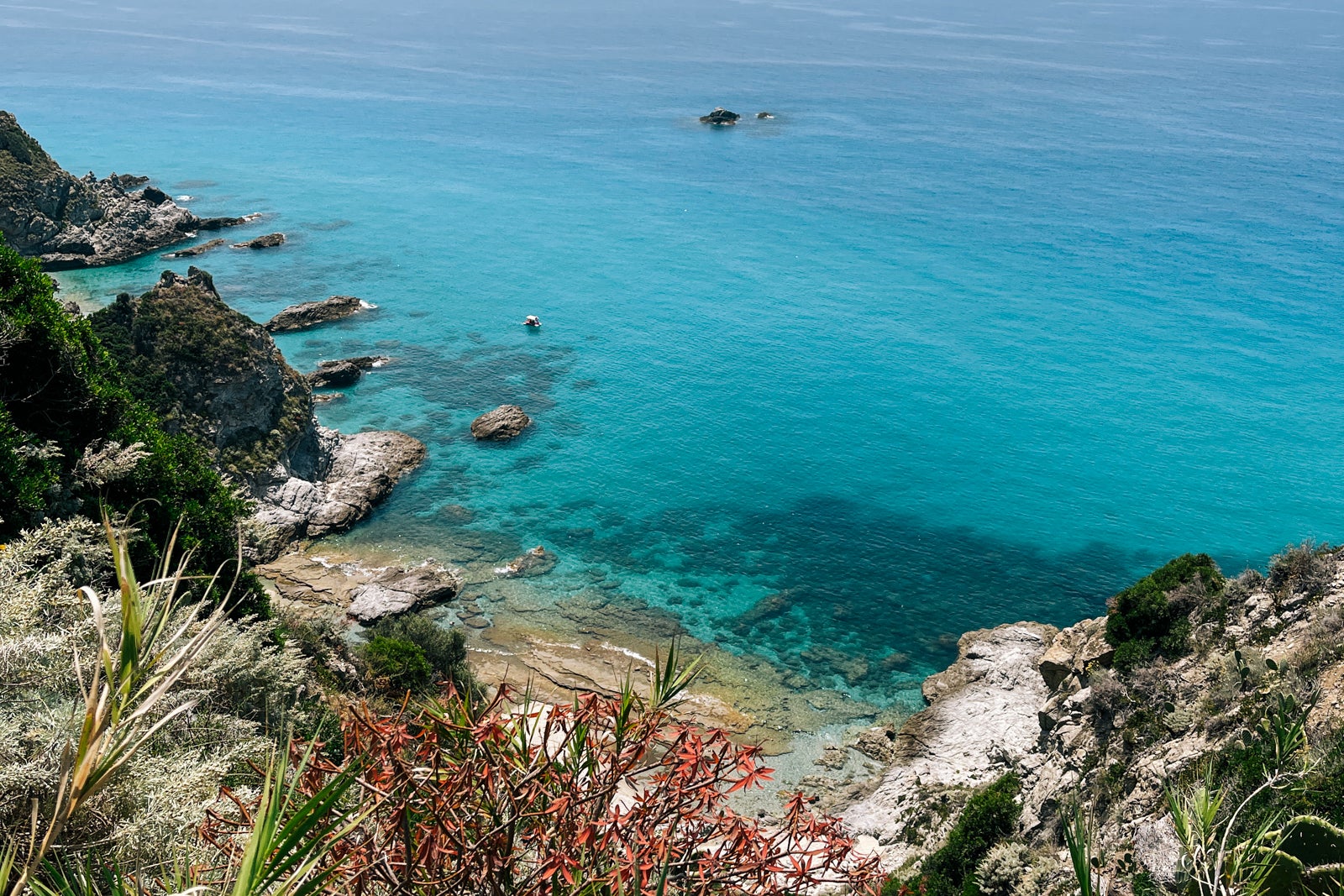
- Spend a day exploring Zungri, Nicotera and other nearby villages and sites.
- Enjoy one last dinner along Corso Vittorio Emanuele in Tropea before departing the following morning.
Days 8–9
- Your Calabrian getaway culminates in the quiet village of Pizzo.
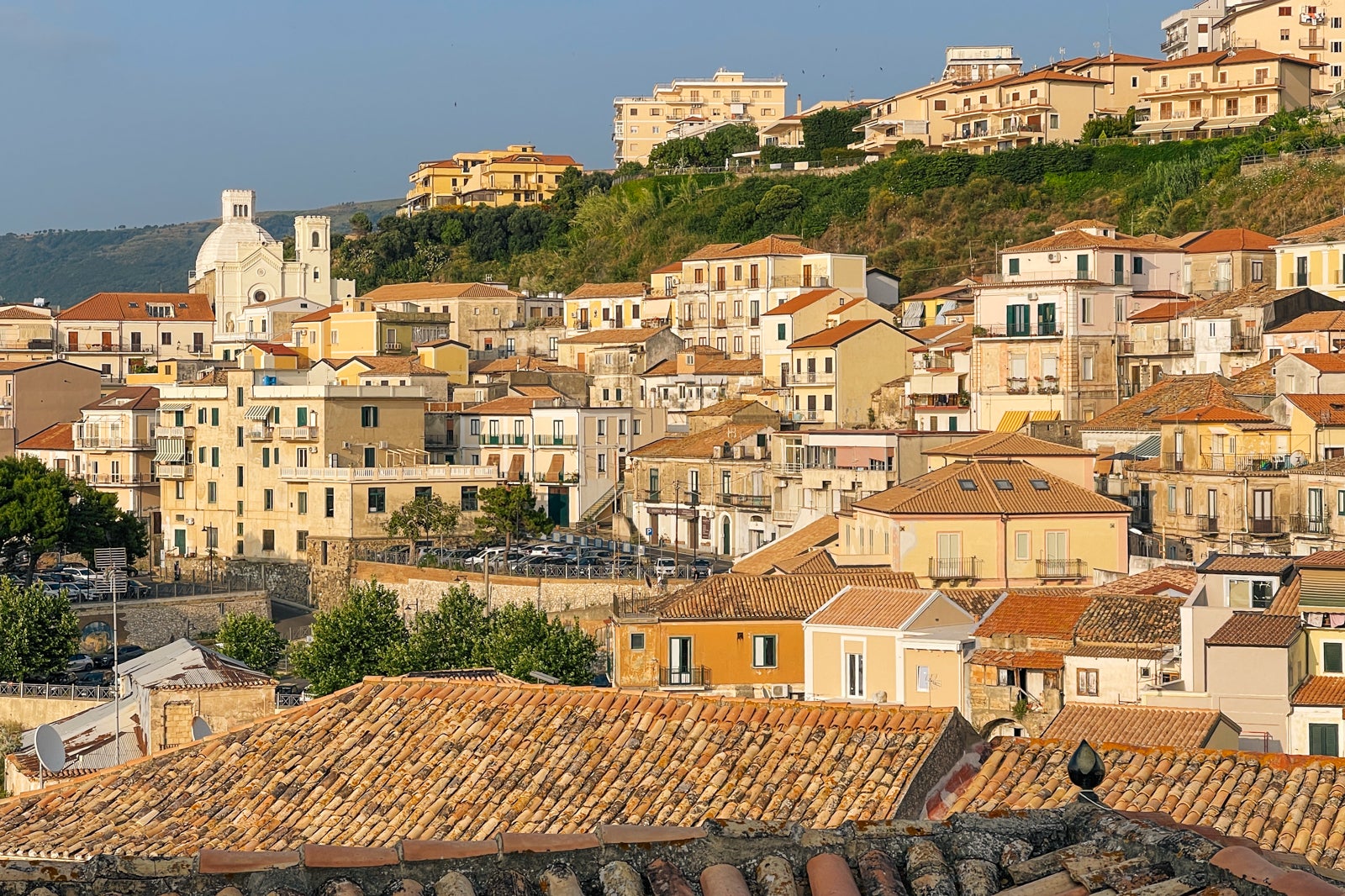
- Visit Piazza Repubblica for its cafe culture and restaurant scene.
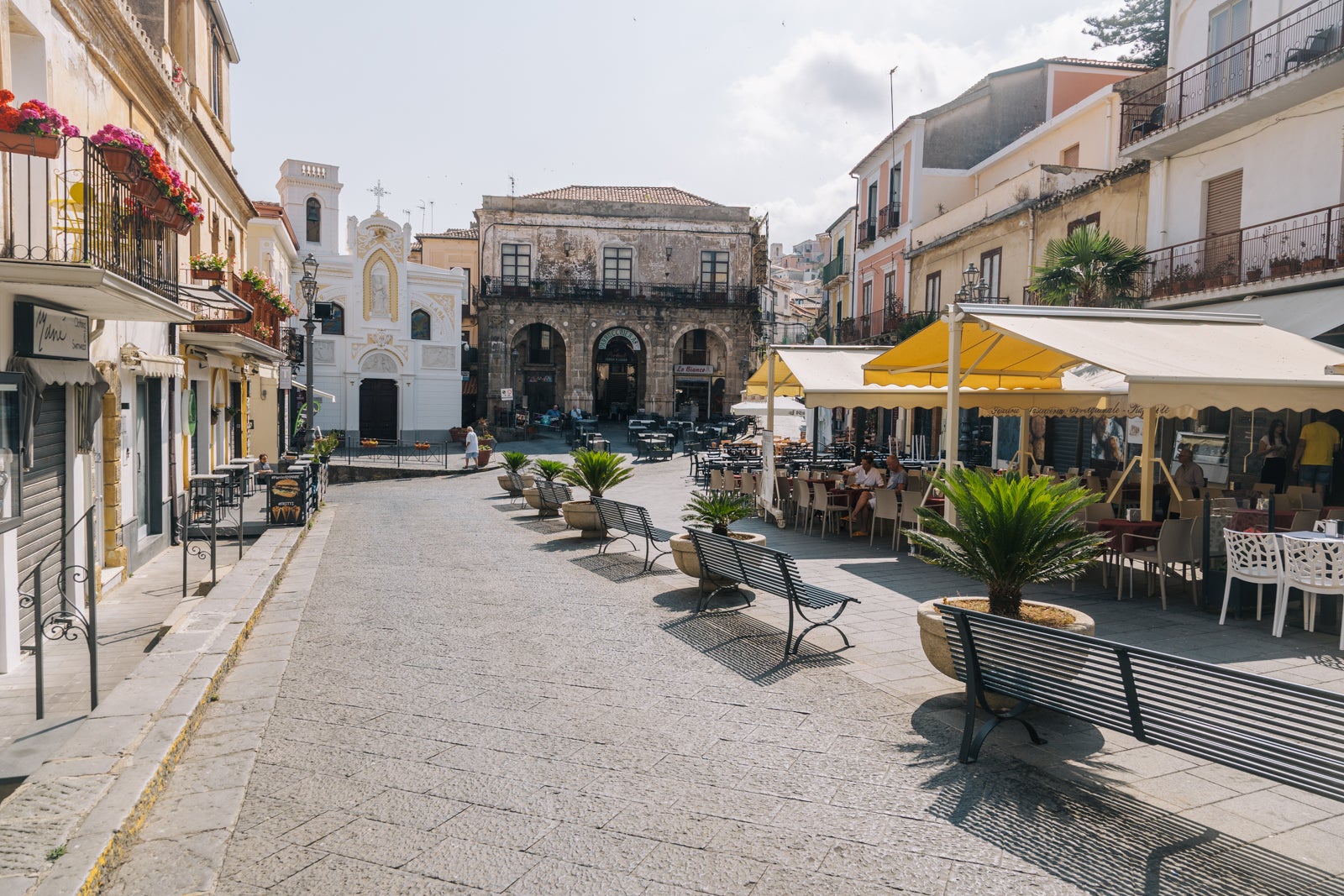
- Take a selfie with artist Edoardo Tresoldi’s wire sculpture Il Collezionista di Venti.
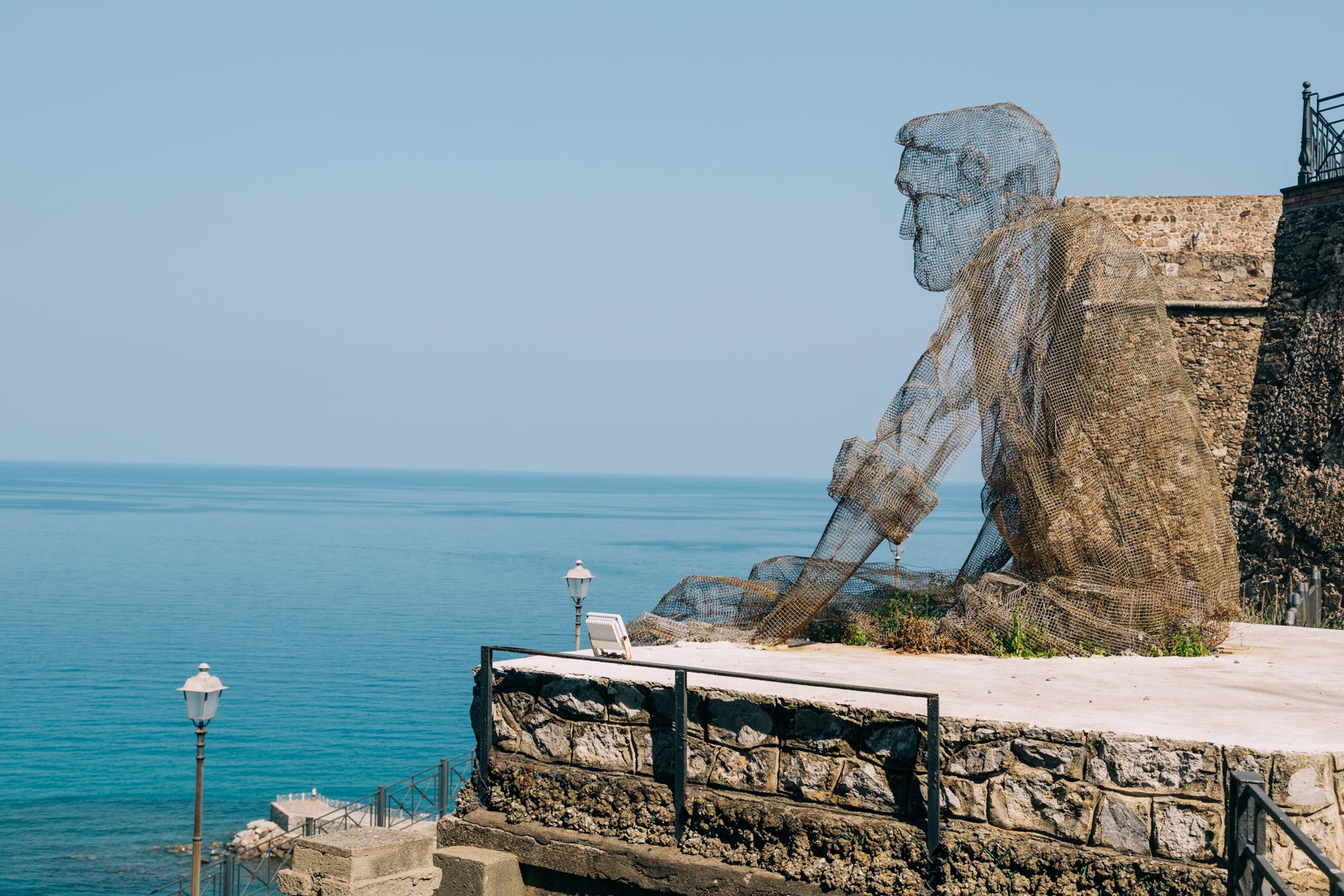
- Explore the Castello Murat and take the time to walk down to the beach and see Chiesa Pieddagrotta (cave church) with its beautiful statues and frescoes. (More on these important sites below.)
Day 10
- Depart your hotel and head to SUF for your flight back home.
Note: Calabria has so many cool places to explore. The above itineraries are just two examples. To learn more about the region, join the Discover Calabria Facebook group, which Pizzo resident Teresa Whitehouse moderates. It offers great firsthand advice!
A taste of Calabria: 3 of my favorite towns
Tropea
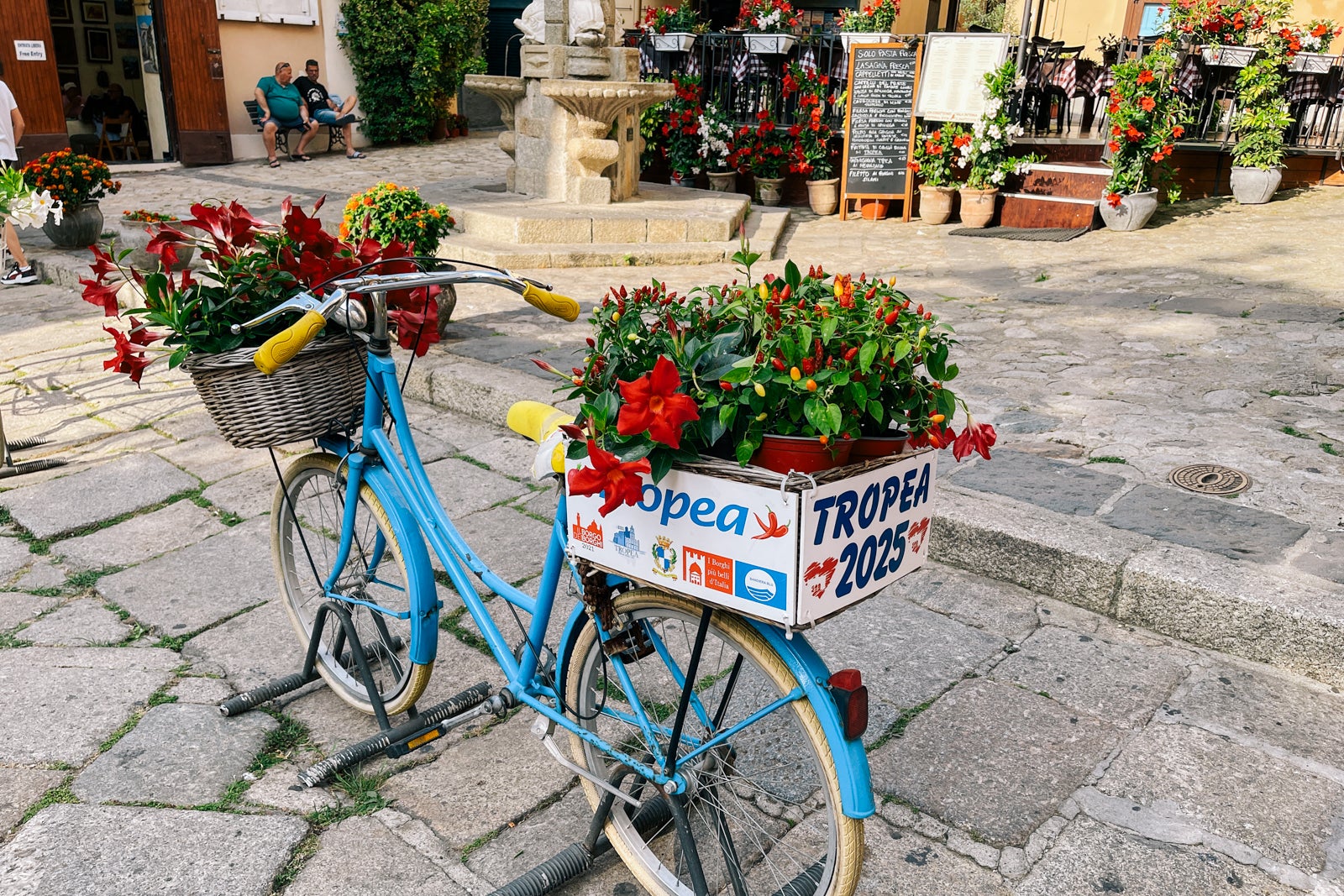
Location: Gulf of Santa Eufemia, Costa degli Dei, Tyrrhenian Sea
If you’ve seen photos of Calabria, they likely featured the Sanctuary of Maria dell’Isola, a stone church perched above the sea on a sandstone rock opposite Tropea.

Tropea is one of the most popular tourist destinations on the Coast of the Gods (Costa degli Dei). Old Town — with Piazza Ercole at its center — is a ZTL zone, meaning you can’t drive in that area unless you’re a resident. It makes this area pedestrian-friendly, which is a good thing since there are dozens of excellent restaurants, bars, cafes and shops lining the main thoroughfare of Corso Vittorio Emanuele.
1 of 3
Tropea. ANDREA ROTONDO/THE POINTS GUY
What to see: The Sanctuary of Santa Maria dell’Isola is a must. It’s 300 steps up to the stone church (and remember, you need to walk down 100 stairs first if you’re coming from Tropea’s Old Town), but it’s worth it for the views and the lovely garden behind the structure. If the stairs are too much, view it from Tropea proper at Belvedere Piazza del Cannone, which offers a fantastic viewpoint of the sanctuary, the sea and the Aeolian Islands in the distance. In fact, on a clear day, you can even see Stromboli.
Beach babies have a few spots to select from, including Spiaggia di Tropea, Spiaggia A Linguata or Spiaggia della Rotonda. Look for “lido” beaches where sunbeds and umbrellas are usually for rent and concessions are nearby.
If you have time, spend a day on the water. Boat tours take you snorkeling, and don’t miss Capo Vaticano, a beautiful cove for swimming that is reached most easily via the water.
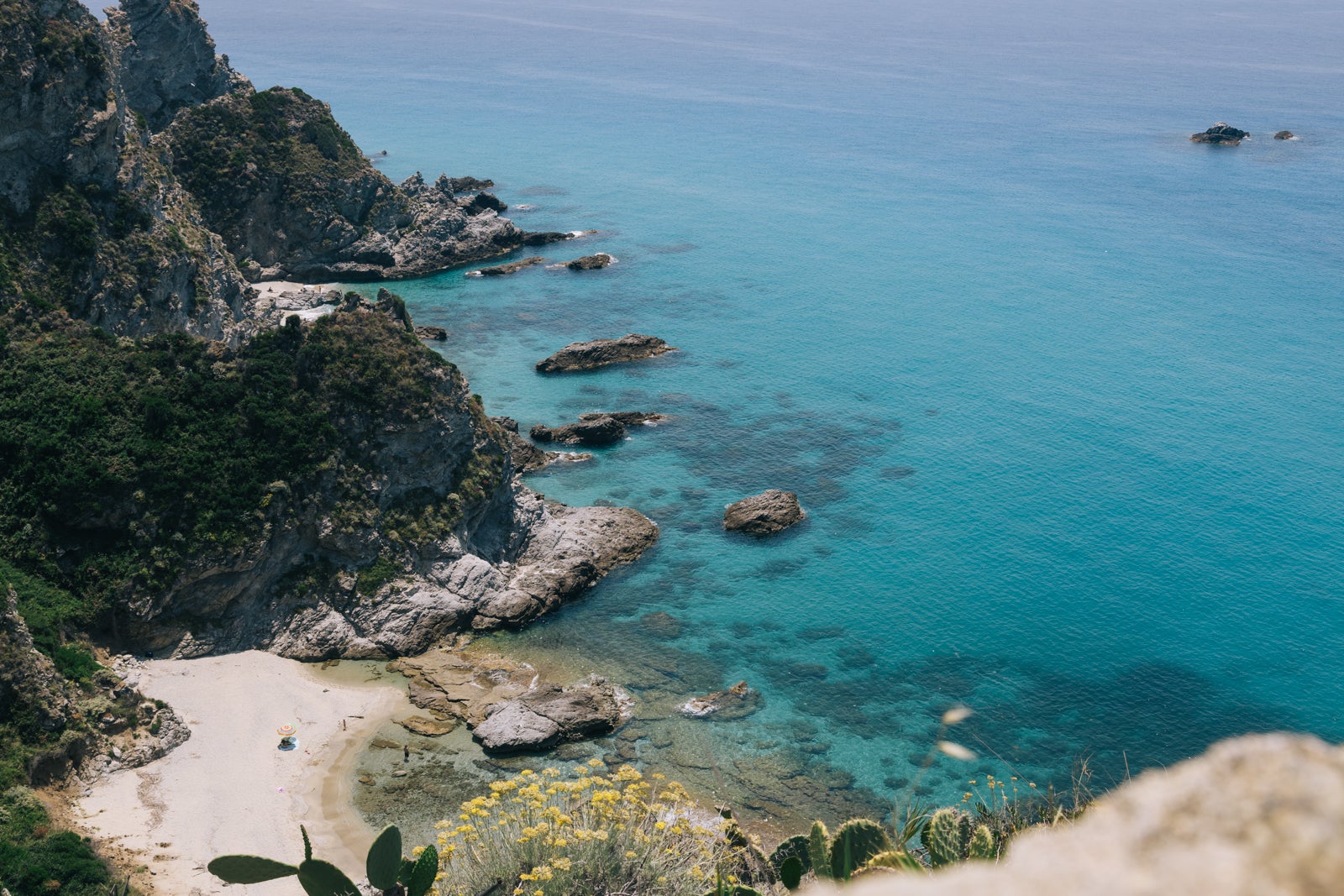
For foodies, I highly recommend this Airbnb Experience: Tropea Food & Wine Tour by Marianna, a rose horticulturist who will take you around the area by car and introduce you to some of the region’s top food producers.
1 of 2
Calabria cheese and meats. ANDREA ROTONDO/THE POINTS GUY
We visited Nicotera to view the Gulf of Gioia, Strait of Messina and Stromboli — and to taste delicious strawberry cremolata (like shaved ice).
1 of 3
Nicotera. ANDREA ROTONDO/THE POINTS GUY
We walked through an olive tree grove in Limbadi to see how olive oil is made and visited a major producer of nduja and other dried meat products in Spilinga.
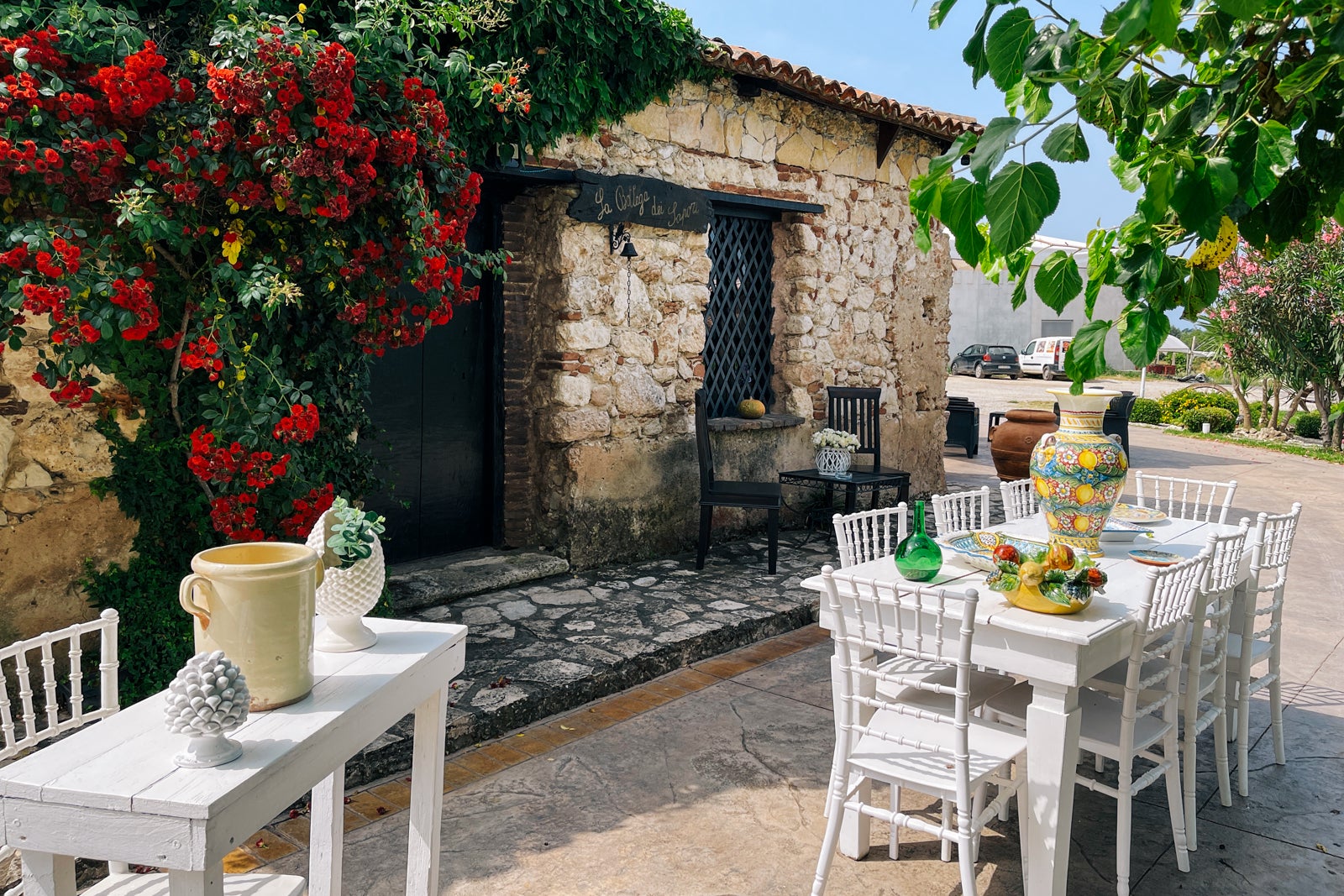
Local culinary specialties: Tropea is home to its famous red onions. You’ll find them, as well as chili peppers, featured in many dishes here. Try the pasta dish fileja, which often features these sought-after onions and nduja, a spicy spreadable sausage made nearby in Spilinga.
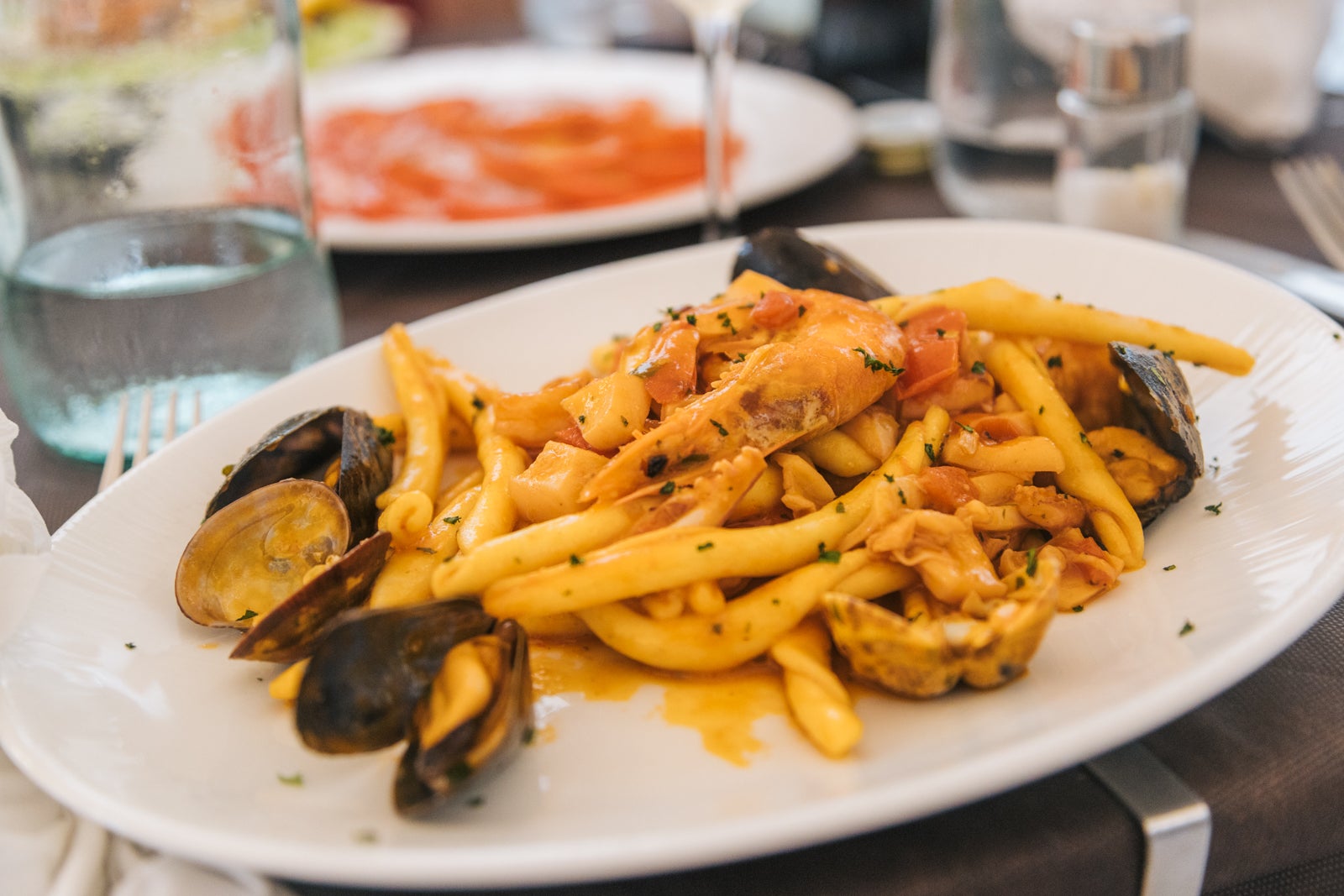
Seafood — especially swordfish and shrimp — is a specialty here, too.
1 of 3
Swordfish, tuna and langostinos at Tropea’s Taverna Antica Grotta. ANDREA ROTONDO/THE POINTS GUY
Caveats: Tropea’s gorgeous beaches are 100 steps down from Old Town. Walking down isn’t so bad (if you don’t have knee issues), but hauling yourself back up on a hot afternoon after swimming in the ocean can be a chore. You can take a ride-hailing service outside of Old Town’s restricted zone to get to the beach, but one day, we couldn’t secure a ride back up to the top. Keep that in mind if anyone in your group has mobility issues.
Where to stay: Palazzo Mottola, Hotel Rocca Della Sena, La Dolce Vita Tropea or Villa Paola
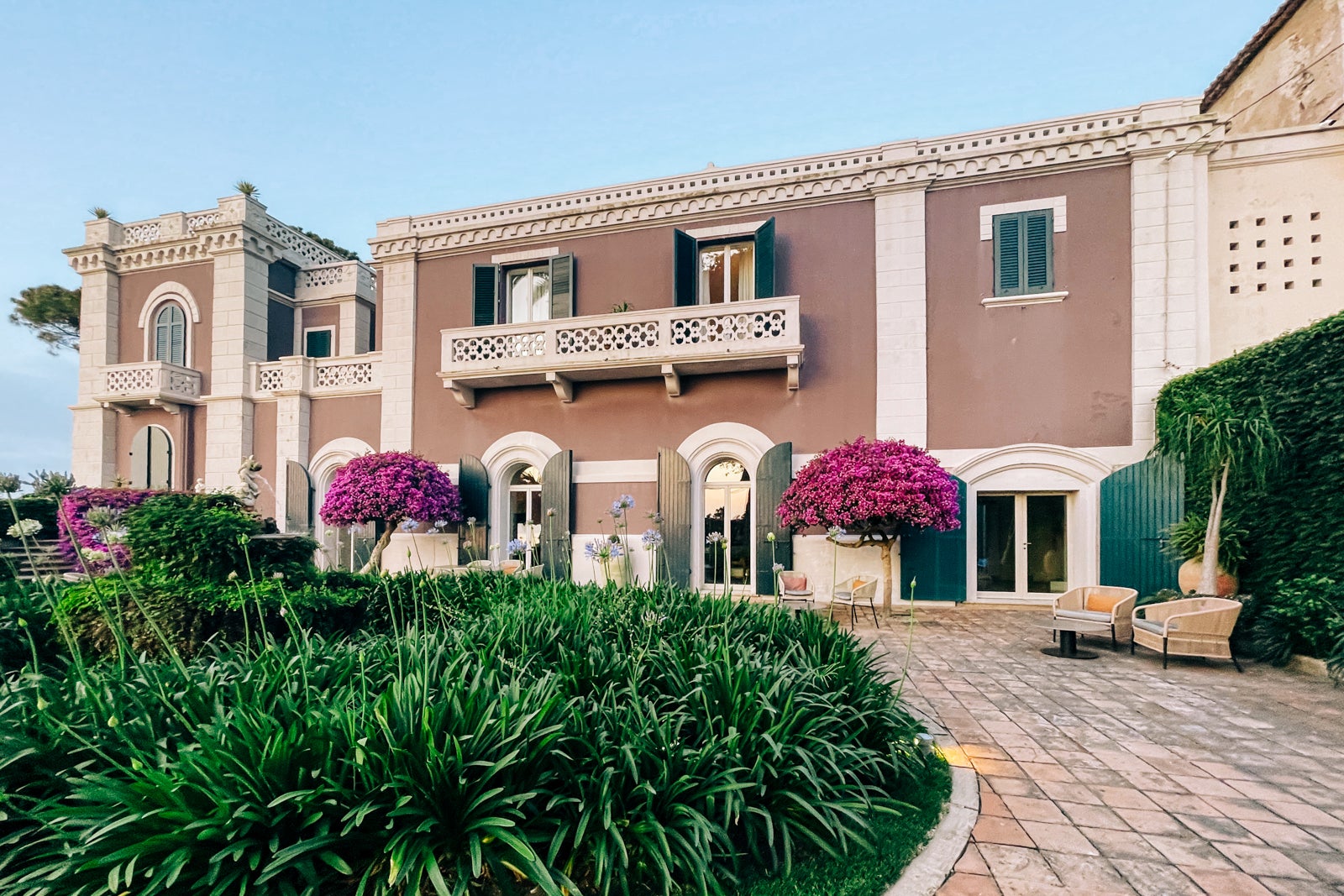
Pizzo
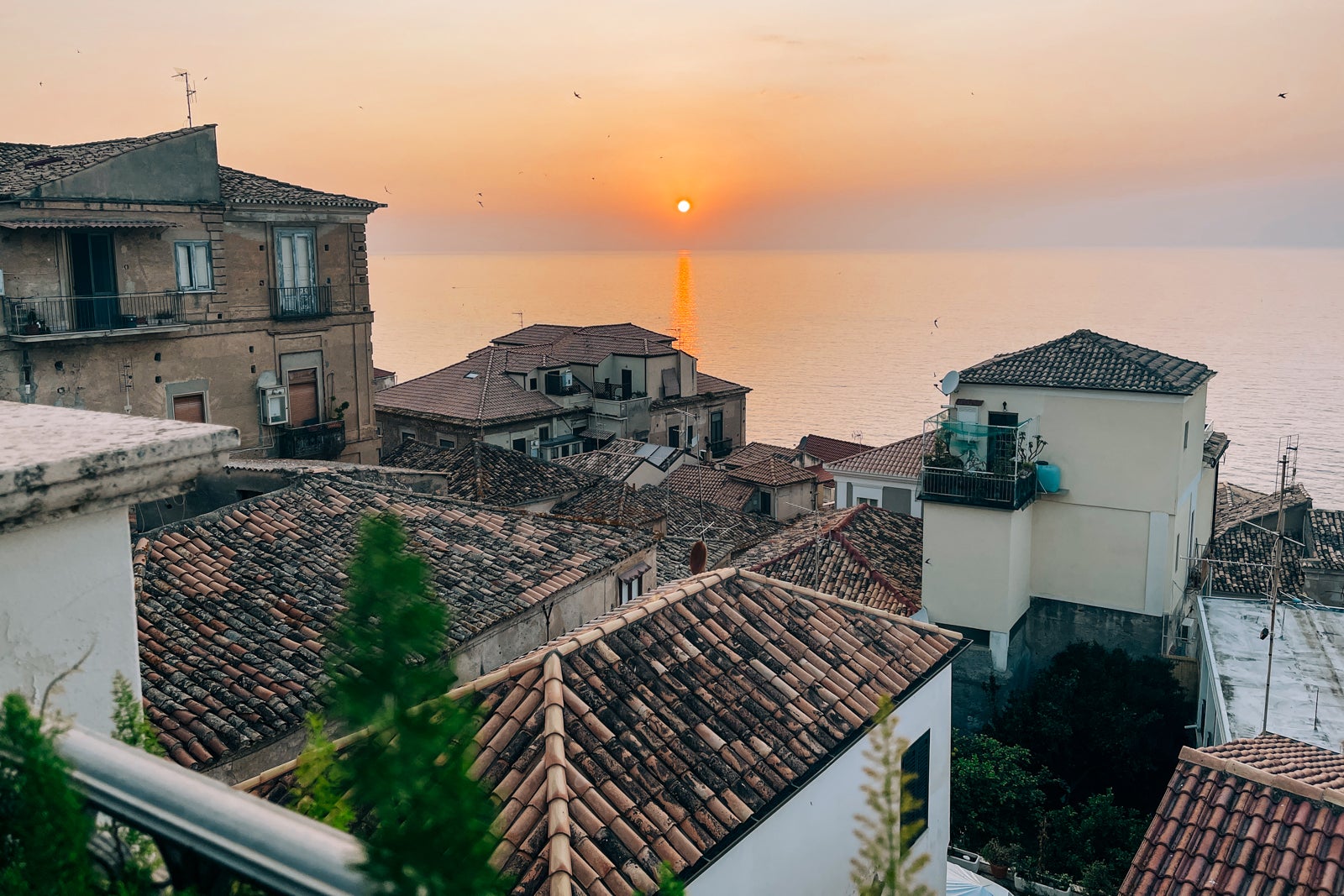
Location: Gulf of Santa Eufemia, Costa degli Dei, Tyrrhenian Sea
Pizzo’s documented history begins in the 1300s with the building of a fort, the arrival of Basilian monks and the development of a prosperous fishing village. The earthquake of 1783 nearly demolished the town; it sustained additional damage in a similar event in 1905.
Today, the town has around 8,000 residents and draws tourists who find it a good base for exploring the Coast of the Gods.
What to see: Piazza della Repubblica is the Pizzo’s main square, and it’s here that you’ll find a vibrant restaurant and cafe scene as well as an overlook of the marina and sea below.
A few steps down and to the right of the square is the wire mesh Il Collezionista di Venti sculpture of a man deep in thought by Italian artist Edoardo Tresoldi.
Now look left, and you’ll see Castello Murat. It’s actually a fortress that was once a prison, with parts built in the 1300s and the rest later in the 1400s. It gets its name from Joachim Murat, former King of Naples and Napoleon’s brother-in-law, who was imprisoned and killed here in 1815.
1 of 2
Pizzo’s Castello Murat. ANDREA ROTONDO/THE POINTS GUY
Chiesetta di Piedigrotta is my favorite part of visiting Pizzo. It’s a “cave church” that displays 19th- and 20th-century sculptures. It’s beautiful in its own right (even for non-believers), and the beach outside the cave entrance is stunning.
1 of 4
Unique cave art at Chiesetta di Piedigrotta in Pizzo. ANDREA ROTONDO/THE POINTS GUY
I prefer Pizzo’s beaches over those of Tropea. They’re less crowded, and nearly everyone except us seemed to be locals.
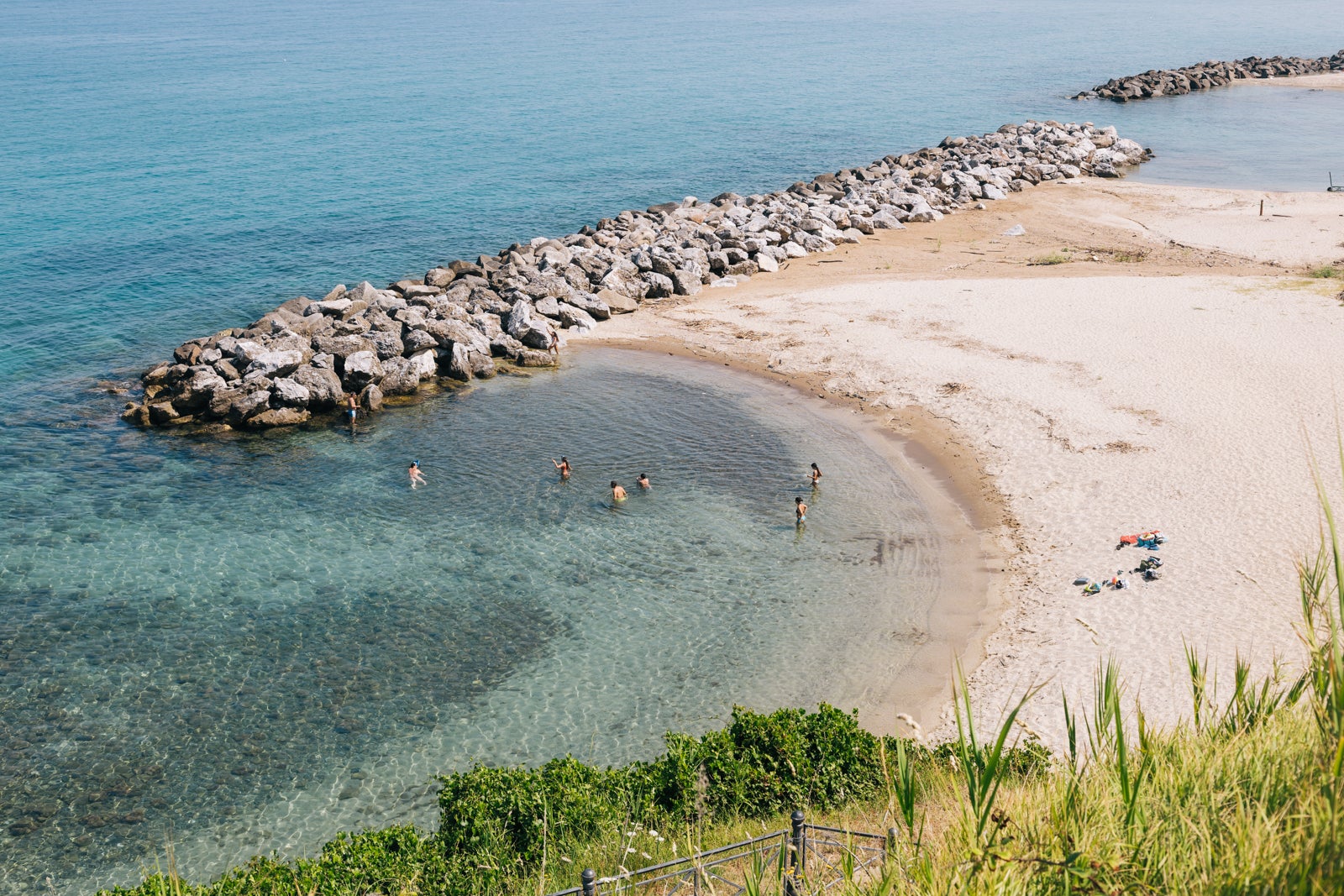
On Thursdays, don’t miss the market (generally open 7 a.m. to 1 p.m.). You can buy fresh fruit, vegetables and flowers; cheese and meats; and home goods, such as pretty ceramic dishes and serving trays.
Local culinary specialties: Tartufo, a delectable ice cream treat, was invented in Pizzo. Chocolate or fruit is rolled in ice cream, then dipped in chocolate or dredged in cocoa powder or crushed nuts. Cafes lining Piazza della Repubblica all vie to serve the best version in town. Bar Gelateria Ercole and Gelateria Artigianale Dante are our top contenders.
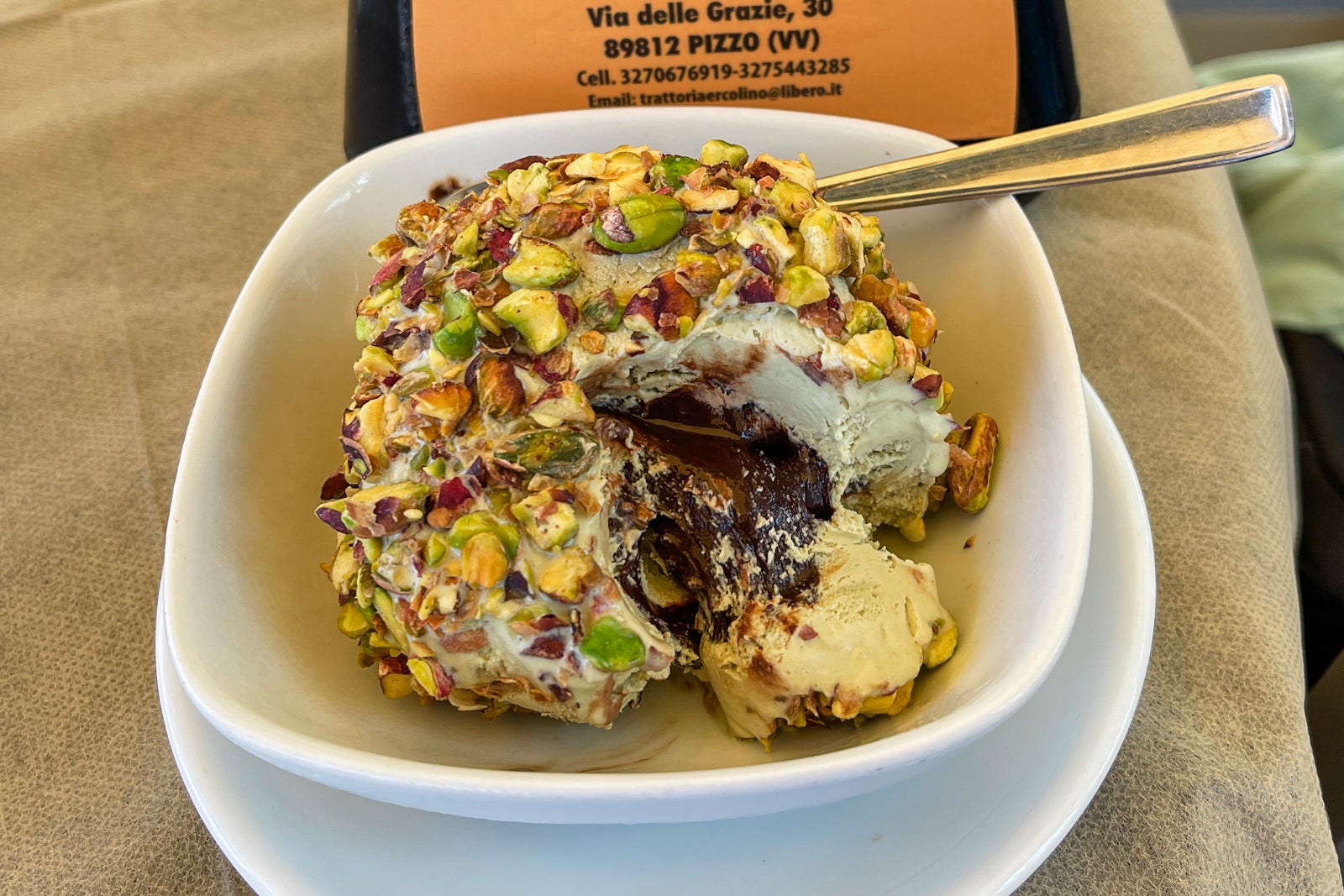
Where to stay: Piccolo Grand Hotel is my favorite hotel in all of Calabria, and it’s right off Pizzo’s main square.
1 of 4
Piccolo Grand Hotel. ANDREA ROTONDO/THE POINTS GUY
Other options include Palazzo Paladini Luxury Suites and Palazzo Pizzo Residence.
Caveats: This is a smaller town and may be too sleepy for some travelers. However, it’s well situated for easy day trips and offers affordable accommodations and dining options.
Reggio Calabria
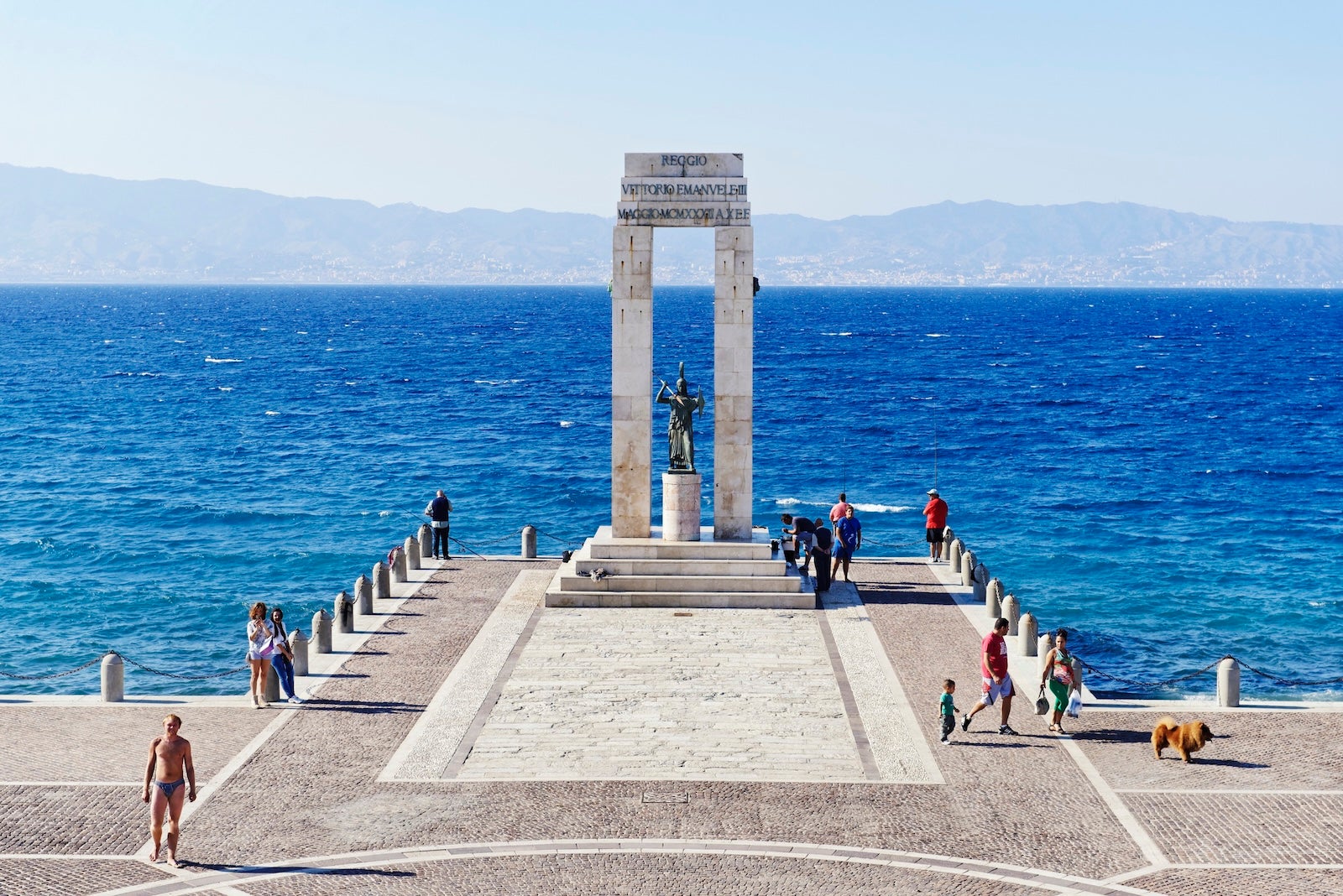
Location: Strait of Messina, across from Sicily
What to see: Start your exploration of Reggio Calabria with the Aspromonte Mountains at your back, and the seaside promenade (Lungomare Falcomata) in front of you. From here, you can spy Sicily in the distance. If you’re lucky and it’s a clear day, you may even see Sicily’s volcano, Mount Etna (it’s active!). Or, get your feet in the sand and walk along the beach here.
Do not miss seeing the Riace bronzes at Museo Nazionale della Magna Grecia. These two statues, cast around 450 BC, were found buried in the seafloor near Riace, Calabria, in 1972. You’ll also find ancient ruins in the area, from a Roman bath to a wall built during Ancient Greek times.

Corso Garibaldi, the city’s main pedestrian road, should be your next point of interest. Enjoy people-watching, stop at a cafe or bar and do some shopping. Buy anything with bergamot in it (jam, candy, tea). It’s a type of citrus that grows in Calabria.
Continue to the Castello Aragonese and then the Cathedral of Reggio Calabria. If you love opera or the theater, the city’s 18th-century Teatro Francesco Cilea is worth a look. Finally, enjoy a traditional Calabrian meal followed by a scoop of gelato. Cesare or Sotto Zero are highly respected purveyors.
Local culinary specialties: In Reggio Calabria, regional dishes include lagane e cicciari (pasta with chickpeas) and pesce spada alla ghiotta (swordfish stew made with olives, tomatoes and capers).
Where to stay: The intimate Medin Blu Hotel — with just 20 rooms — is a lovely property in a restored 1915-era Art Nouveau building. Plus, it has nearby parking (not always a given at Italian hotels), a rooftop bar and restaurant, so how can you go wrong?
Caveats: Honestly, the only critique of Reggio Calabria is that I wish it had a few more luxury accommodations, but that’s not the end of the world.
Why Calabria might not be for you
I adore Calabria and Southern Italy in general, but vacationing here may not be a fit for you for these reasons:
No nonstop flights from the US
- There are no nonstop flights available from the U.S. You’ll need to connect through a European city. (However, if you plan to visit Sicily first, you can fly nonstop to Palermo or Catania and then take a ferry from Messina to Calabria.)
Infrastructure can be challenging
- Air-conditioning is not as common as in the U.S. Many restaurants aren’t climate-controlled.
- Not all hotels or public buildings have elevators.
- Always check to see if the hotels you’re interested in have Wi-Fi. Some do not.
- Many roads — especially in the mountainous interior of Calabria — are narrow, steep and may be difficult for some to navigate (especially in a manual rental car).
- Uber and other rideshare options are only available in some larger cities and towns.
Life is laid-back here
- Most shops and restaurants close after lunch and don’t reopen until late afternoon or dinnertime.
- Posted hours of operation are only a suggestion, especially in smaller villages that don’t cater to tourists.
- Nightlife? Umm. There’s not much here. Like other parts of Southern Italy, the migration of its youth is a major problem and because of that, you won’t find vibrant nighttime recreation centers like in Rome or Milan.
Bottom line
Calabria is the place to add to your travel wish list if you want to avoid crowds, experience a new Italian destination at a slower pace and have authentic experiences with people who were not only born and raised there but also have ancestral lineage going back hundreds of years.
It’s a very special region of Italy and one I’ll go back to again and again.
Want to visit other parts of Italy? Here’s some inspiration:



